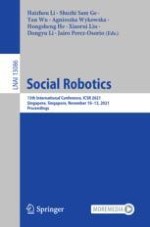2021 | Book
Social Robotics
13th International Conference, ICSR 2021, Singapore, Singapore, November 10–13, 2021, Proceedings
Editors: Dr. Haizhou Li, Prof. Dr. Shuzhi Sam Ge, Yan Wu, Agnieszka Wykowska, Assist. Prof. Hongsheng He, Xiaorui Liu, Prof. Dongyu Li, Jairo Perez-Osorio
Publisher: Springer International Publishing
Book Series : Lecture Notes in Computer Science
